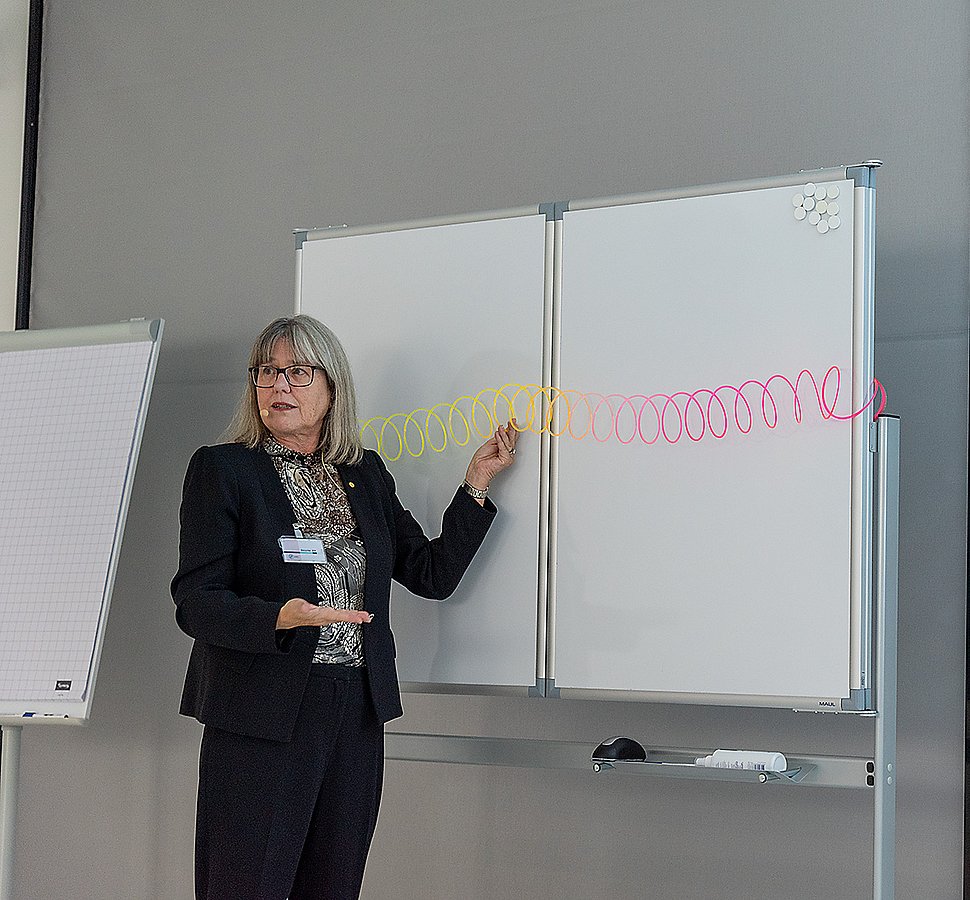Creating the laser hammer and winning the Nobel Prize: Donna Strickland visits MPL
Professor Donna Strickland visited the Max Planck Institute for the Physics of Light (MPL) on October tenth, 2022, as part of the Distinguished Lecturer Series (DLS) and gave a talk on the work that won her the 2018 Nobel Prize in Physics.

"I always like to unofficially call this talk: what I did during my PhD to win a Nobel Prize" Donna Strickland explained jokingly at the beginning of her talk. With this relaxed and humorous manner, she led through her research work for an hour. The lecture was followed by more than 250 listeners in the Leuchs-Russell Auditorium and online.
Donna Strickland won the 2018 Nobel Prize in Physics with her doctoral advisor, Gérard Mourou, who nowadays conducts research at the Ecole Polytechnique in France. She was the third woman to win the Nobel Prize in physics after Marie Curie and Maria Goeppert-Mayer and the first ever winner from the University of Waterloo, Canada. She received the prize for the first article she published in her research career. Strickland said, "People always like to emphasize the first paper. But you also have to remember that I was already in my fourth year of my doctorate and hadn't published a paper yet. You have to think about that, too!"
Strickland and Mourou won the award because in 1985, as part of Professor Strickland's doctoral research, they successfully developed a new technique to generate ultrashort, high-intensity laser pulses. This is called chirped pulse amplification (CPA). Today, CPA is the standard method for almost all high-intensity lasers. Professor Strickland explained in her talk, "I always say I wanted a laser hammer. Sometimes with a laser you need a lot of energy and sometimes peak power is important. It's like trying to push a nail into the wall with your hand, or you just use a hammer." She worked with her thesis advisor to find a way to take a short laser pulse, stretch it out in time, amplify it, and finally compress it back into a short, intense pulse.
Professor Strickland was welcomed by MPL Director Florian Marquardt and research group leader Hanieh Fattahi. In the talk that followed, Strickland vividly explained the historical background of laser research as well as her own work. She also talked about why she asked a colleague to climb through ventilation shafts in the lab for her in the middle of the night, why she used exactly 1.4 kilometers of optical fiber cables for her experiments, and what she sees as the next important goals in laser research. Last but not least, there was a short video that delicate viewers should rather not watch. This is because CPA has, among other things, also created the prerequisites for modern eye laser procedures. The clip shows how a thin layer of cornea is partially detached with the help of a high-intensity laser in order to reach the lower layers of the skin. Professor Strickland herself, however, still prefers to wear glasses: "My doctor can barely manage to give me eye drops!" she laughed.
Both after and before the lecture, MPL researchers had the opportunity to exchange ideas with the Nobel laureate in personal conversations. This exchange of knowledge is an important motivation for the Distinguished Lecturer Series at MPL.
Photo (© Florian Ritter, MPL): Donna Strickland holding her DLS lecture at Max Planck Insitute for the Science of Light
Contact
Edda Fischer
Head of Communication and Marketing
Phone: +49 (0)9131 7133 805
MPLpresse@mpl.mpg.de





